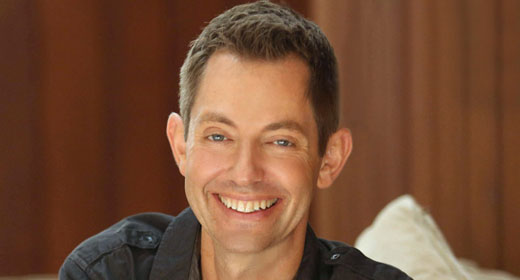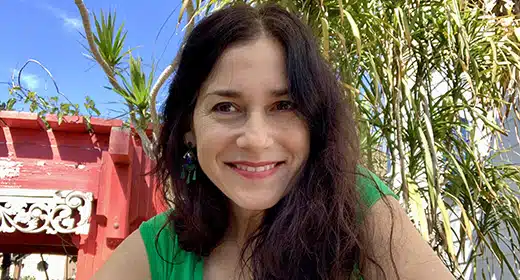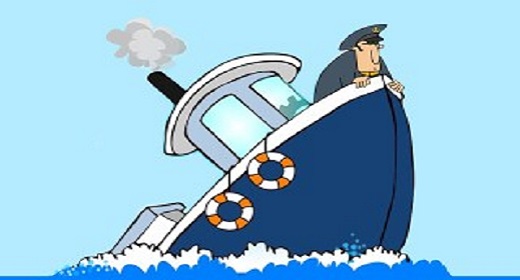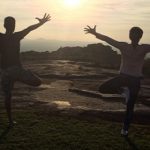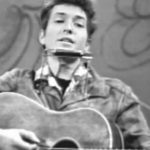by Benjamin Epstein: One of the most elusive figures of modern times, Castaneda recently materialized, to great surprise, at a small conference in Anaheim, California. Reporter Benjamin Epstein was on hand to score a coup…
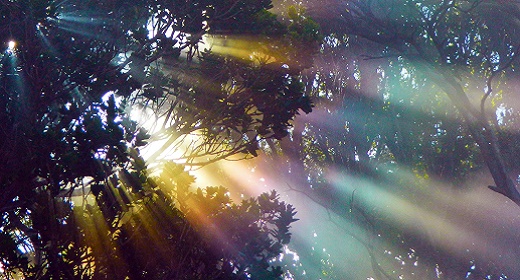
He is the 20th century’s own sorcerer’s apprentice. He is the invisible man, ephemeral, evanescent: now you see him, now you don’t. He is a navigator making his way through a living universe in exquisite flux. Or as Carlos Castaneda himself might say, he is a moron, an idiot, a fart. It’s been said that Jesus Christ was either the Son of God or the greatest liar who ever lived. Carlos Castaneda, who may have a cult following but says deities are the last thing people need, presents a similar conundrum. Critics grapple for middle ground: One called him a “sham-man bearing gifts . . . He lied to bring us the truth.”
The jury has been out ever since books such as The Teachings of Don Juan took the public and academia by storm in the 1960s and 70s, and it’s still out. Castaneda has now produced nine books he claims are based on his supernatural experiences with Don Juan Matus, a Yaqui seer. To remain invisible, he says, is the sorcerer’s way. He never allows photographs or a tape recording of his voice. He only rarely grants interviews. In the 80s, he effectively vanished altogether. But the books continue to sell (8 million in 17 countries) and have never been out of print. In 1993, he began to give occasional seminars, and the following year The Art of Dreaming appeared.
Despite ads promoting “Carlos Castaneda’s Tensegrity,” even event organizers didn’t know whether Castaneda would actually show up at a recent weekend seminar near Disneyland in Anaheim. Yet 400 devotees from around the world–about a third from California–paid $250 each to attend, whether Castaneda showed or not. They came to learn a series of “magical passes,” movements intended to heighten perception.
“It is a thinking universe, a living universe, an exquisite universe!” Castaneda said, exuberantly kicking off the seminar. “We have to balance the linearity of the known universe with the nonlinearity of the unknown universe.” The charismatic Castaneda proved amazingly convincing when describing life among inorganic beings, with whom he apparently spends a great deal of time; the assemblage point, a place about an arm’s length behind our shoulder blades that can be shifted to visit other realms; and a predatory universe in which “flyers” incessantly feed on mankind’s awareness, taking the sheen off our luminous eggs and leaving only a rubble of self-absorption and egomania.
He invents none of this, he insists. I’m not insane, you know. Well, maybe a little insane. But not ridiculously insane!”
He is also charming, energetic, fit, and funny. And at the conclusion of his opening talk, Castaneda responded to a request for an interview by unexpectedly inviting the writer to lunch.
Sitting in a coffee shop in Anaheim opposite Castaneda was enough to realign anybody’s assemblage point: The writer later took his nonlinearity to heart, slipping easily between lunch and workshop talks, and indulging in the conversational format that Castaneda often used to elucidate his master’s ideas. After all, Castaneda had replaced Don Juan as nagual, the head sorcerer, a being with double luminous spheres, and if it was good enough for one nagual, it’s good enough for another.
At the table were several Tensegrity staffers and the three women chacmools who helped Castaneda compile the movements and who taught them step-by-step at the seminar.
“Is this what you’ve been doing all this time, magical passes?” I asked Castaneda.
“Noooo . . . . I was very chubby,” he said. “Don Juan recommended an obsessive use of magical passes to keep my body at an optimum. So in terms of physical activity, yes, this is what we do. The movements also force our awareness to focus on the idea that we are spheres of luminosity, a conglomerate of energy fields held together by special glue.”
“Is Tensegrity the Toltec t’ai chi? Yaqui yoga?” I asked.
“To compare Tensegrity with yoga or t’ai chi is not possible. It has a different origin and a different purpose. The origin is shamanic, the purpose is shamanic. It has to do with our reason for being. Our reason for being is to face infinity
“We’re all going to face infinity, at the moment of dying,” he said. “Why face it when we are weakest, when we are broken? Why not when we are strong? Why not now? You have to face it pragmatically No idealities allowed.”
“Where would Jesus fit into all this? Where would Buddha fit in?”
“They are idealities,” Castaneda replied. “They are too big, too gigantic to be real. They are deities. One is the Prince of Buddhism, the other is the Son of God . . . . Idealities cannot be used in a pragmatic movement.
“Allowing your perception to break the interpretation system–a tree ceases to be a tree and becomes sheer energy–that is a pragmatic maneuver. The things shamans deal with are extremely practical. They break down parameters of normal historical reality Magical passes are just one aspect of that.”
Castaneda is very negative about religion. But these aren’t your usual diatribes: “Leave Jesus on the cross. He’s very happy there! Don Juan said, ‘Don’t bother him, leave him alone. Don’t ask him “why are you there crucified.” He’d go bananas trying to explain to you why.’ So I did that. He said hello to me, and goodbye.”
The waiter arrived to take our lunch orders. The only choices under discussion seemed to be top sirloin, prime rib, and filet mignon, hardly the snuggest fit with most New Age disciplines.
“The sorcerers say that whether you’re eating lettuce or a steak, it’s a sentient being,” chacmool Kylie Lundahl explained. As it turned out, the chacmools, named for the gigantic, reclining guardian figures of the Mexican pyramids, were quite literally here today, gone tomorrow. Castaneda relieved them of their duties at the end of the seminar, during his closing remarks. Nobody ever said the warrior’s way would be easy.
Castaneda ordered a melted cheese on rye with a side of bacon and fries.
Don Juan was once described as “an enigma wrapped in mystery wrapped in a tortilla,” and Castaneda followed suit. His agent, Tracy Kramer, and Cleargreen, Inc., which organizes the seminars, are based in Santa Monica. Where Castaneda spends his time is unclear. If a passing remark at the seminar was to be taken literally, he pays property taxes somewhere.
“I don’t live here,” Castaneda said. “I’m not here at all. I always use the euphemism ‘I’ve been in Mexico.’ All of us divide our time between being here and being pulled by something that is not describable but that makes us visitors into another realm. But you start talking about that and you start sounding like total nincompoops.
“I had once an interview. First thing the interviewer said was, “They tell me you turned into a crow. Is that true? Hahahaha.’ I tried to explain to him about intersubjectivity. ‘Pfhhhh,’ he said, ‘tell me yes or no.’ I said no.”
“Why don’t you allow yourself to be photographed or tape-recorded?” I asked.
“Recording is a way of fixing you in time,” Castaneda answered. “The stagnant word, the stagnant picture, those are the antithesis of the sorcerer . . . . Maybe you’ve seen a drawing of Carlos Castaneda [by Richard Oden for Psychology Today in December 1977]. There was no photograph, so he drew it. This was 30 years ago. No good. He decided to draw it again. It was a flop.”
Photographs are not all that stand still. “The Word of God is unchanging,” he said. “It is a living universe. What is in flux is what is alive. An unchanging word must by definition pertain to a dead world. In a universe that is forced to change there is a written word not forced to change? That is the world of a taxidermist.”
When Castaneda’s melted-cheese sandwich arrived, the rye was marbled with pumpernickel. “What is this, chocolate bread?” he asked before sending it back. My own mind was worlds away, perhaps on a bench in Oaxaca.
“According to your book The Eagle’s Gift, Don Juan Matus didn’t die, he left, he ‘burned from within.’ Will you leave or will you die?”
“Since I’m a moron, I’m sure I’ll die,” Castaneda replied. “I wish I would have the integrity to leave the way he did . . . . I have this terrible fear that I won’t. But I wish. I work my head off–both heads–toward that.”
I recalled an article from at least a decade ago calling Castaneda the “godfather of the New Age.”
“It was ‘grandfather’!” he protested. “And I thought, please call me the uncle, or cousin, not grandfather! Uncle Charlie will do. I feel like hell, being the grandfather of anything. I’m fighting age, senility and old age, like you couldn’t believe. I was senile when I met Don Juan, I’ve fought for 35 years . . . .
“To be young and youthful is nothing,” said Castaneda. “To be old and youthful, that is sorcery!”
Castaneda, for whom ambiguity is a way of life to be ruthlessly pursued, is both. And his age is as good a place as any to get a sense of the man.
According to Contemporary Authors, Castaneda lists his birth date and place as December 25, 1931, Sao Paulo, Brazil; immigration records say December 25, but 1925, and Cajamarca, Peru; other sources cite the late 1930s. One New York Times article put him at 66 years old in 1981.
So he’s somewhere between 60 and 80, most likely 64. Or 70. Similarly, otherwise reliable sources variously list the year he earned his Ph.D. in anthropology from UCLA as 1970 and 1973. In other words, this is one slippery organic being.
I asked about inorganic beings.
“They are possessors of consciousness but not possessors of an organism,” Castaneda responded. “Why should awareness be the exclusive possession of organisms?”
The Art of Dreaming ends with Castaneda recounting an episode in the mid-70s when he and Carol Tiggs were “dreaming” in a hotel room in Mexico City, and Tiggs disappeared into those dreams. (She was on a journey in the “second attention,” a state of consciousness not devoured by the “flyers.”) According to Castaneda, she reappeared 10 years later in a bookstore in Santa Monica, where he was giving a talk.
It was the reconstituted Tiggs who provided the impetus to compile the “magical passes” of Tensegrity, According to Castaneda, Don Juan taught four disciples separate lines of ever-changing magical passes. The other two, Florinda Donner-Grau and Taisha Abelar, have each published accounts of their apprenticeships, both markedly different from Castaneda’s but endorsed by him.
Over the past 10 years, the group “fixed the passes,” arriving at a consensus generic enough to be used by mankind. If the movements of Tensegrity (the name derives from an architectural term related to skeletal efficiency, happily combining “tension” and “integrity”) often seem angular and fierce in character, they are intended to produce a jolt.
“I saw once a beautiful science fiction movie in which creatures from another planet appeared,” Castaneda said, “veeeery slowly A change in perception is never like that. It is like this. Yank it out! You cancel the parameters of normal perception. You move into it like a robber bandit. Almost immediately, the robber bandit comes back. It’s just a moment. But the moments get longer and longer.”
The chacmools may have been erased, but not Tensegrity A new formation of warrior guardians were set to lead future seminars with lectures to be given by all four Don Juan disciples–and an inorganic being called the blue scout.
Don Juan’s premise was that the world as we know it is only one version of reality, a set of culturally embedded “agreements” and “descriptions.” Castaneda addressed the futility of the usual avenues of inquiry:
“If you seek with the mind, it will not take you anywhere, except to a tautological situation where you repeat the obvious. In science, the tautological questions prove themselves. That the art of our science. . . ‘All these variables and nothing else.’ We are champions of pseudo control–we reduce the problem to manageable science. What a fantasy!
“One day on my way to the cafeteria at UCLA, I didn’t see people anymore, I saw energies, blobs, luminous spheres. It was dazzling. Before that, nothing existed except me, me, me. I went to talk to a psychiatrist I worked with. He very kindly prescribed a tranquilizer and said, ‘Carlos, you’re working too hard. Take two days off.’ It was impossible to establish a dialogue with him.”
Castaneda’s own inquiries have led him from academic anthropology to practical hermeneutics, the science of interpretation; he launched a newsletter, The Warriors’ Way: A Journal of Applied Hermeneutics, in January. Titles under consideration for a gigantic work in progress have included “Ethnohermeneutics” and “Phenomenological Anthropology.”
“When sorcerers see, hermeneutics is the ultimate affair for us,” Castaneda said. Seeing for the rest of us apparently involves only the visual sense, and then only minimally.
“When you look at me now, what do you see?” I asked.
“I have to be in a special mood to see,” he said. “It is very difficult for me to see. I’ve got to get very somber, very heavy. If I’m lighthearted and I look at you I see nothing. Then I turn around and I see her, and what do I see? ‘1 joined the navy to see the world, and what do I see? I see the sea!’
“I know more than I want to know. It’s hell, true hell. If you see too much, you become unbearable.”
Castaneda ordered a cappuccino, then meticulously removed the foamed milk teaspoon by teaspoon.
According to Castaneda, most sorcerers must remain celibate in order to conserve energy. It all depends on the circumstances under which they were conceived.”
Most of us are what we call BFs, the product of bored fucks,” he explained. “How was I conceived? Was it in the middle of great sexual excitation, or was it nonsense, idiotic, pointless? Mine was stupid. The two people involved didn’t know what they were doing. I was conceived behind a door, so I came out very nervous, watching. And this is the way I am, basically For me to make use of energy I don’t have is lethal.”
“What about married people?”
“That question has come up a lot. It’s a question of energy,” he said. “If you know you were not conceived in a state of real excitation, then no. On one level, it hasn’t mattered if people are married. With the launching of Tensegrity, we don’t really know what will happen.”
“You don’t know what is going to happen? Sounds irresponsible.”
“How can you know?” he asked. “This is an implication of our syntactical system. Our syntax requires a beginning, development, and end. I was, I am, I will be. We are caught in that. How can we know what you will be capable of if you have sufficient energy?
“I am giving you a series of ideas, if you have the balls to take them seriously. Maybe you say this is idiotical, what kind of shit is this? Like the little boy victims [whining], ‘But what is going to happen to me?’ They’ll never find out.
“The other three disciples–those farts–have balls; these are huge women with the biggest balls you’ve ever seen. Try to stop Taisha Abelar and see what happens. Try to stop Florinda.”
The fourth disciple is no squeaker himself.
“Don Juan categorized people into three types,” he said. “One was farts, like me, a smelly fart–very assertive, ready to tell you, ‘Fuck you, are you sure that’s the way to do it?’ and Don Juan would very patiently assure me that, yes, he was sure. I don’t have that patience myself. If somebody asks me am I sure, I go bananas because I’m not sure!
“The other, golden piss–the sweetest, wonderful beings. They could die for you, or so they say They won’t, but they say it, which is very nice–nicer than the fart but then you die for him.
“The third type, puke. Not fart, not piss, just puke–the kind that doesn’t have anything to give, but promises the world, and has you begging . . . .
“Fortunately I was fart. And Don Juan had a ball with this fart.”

